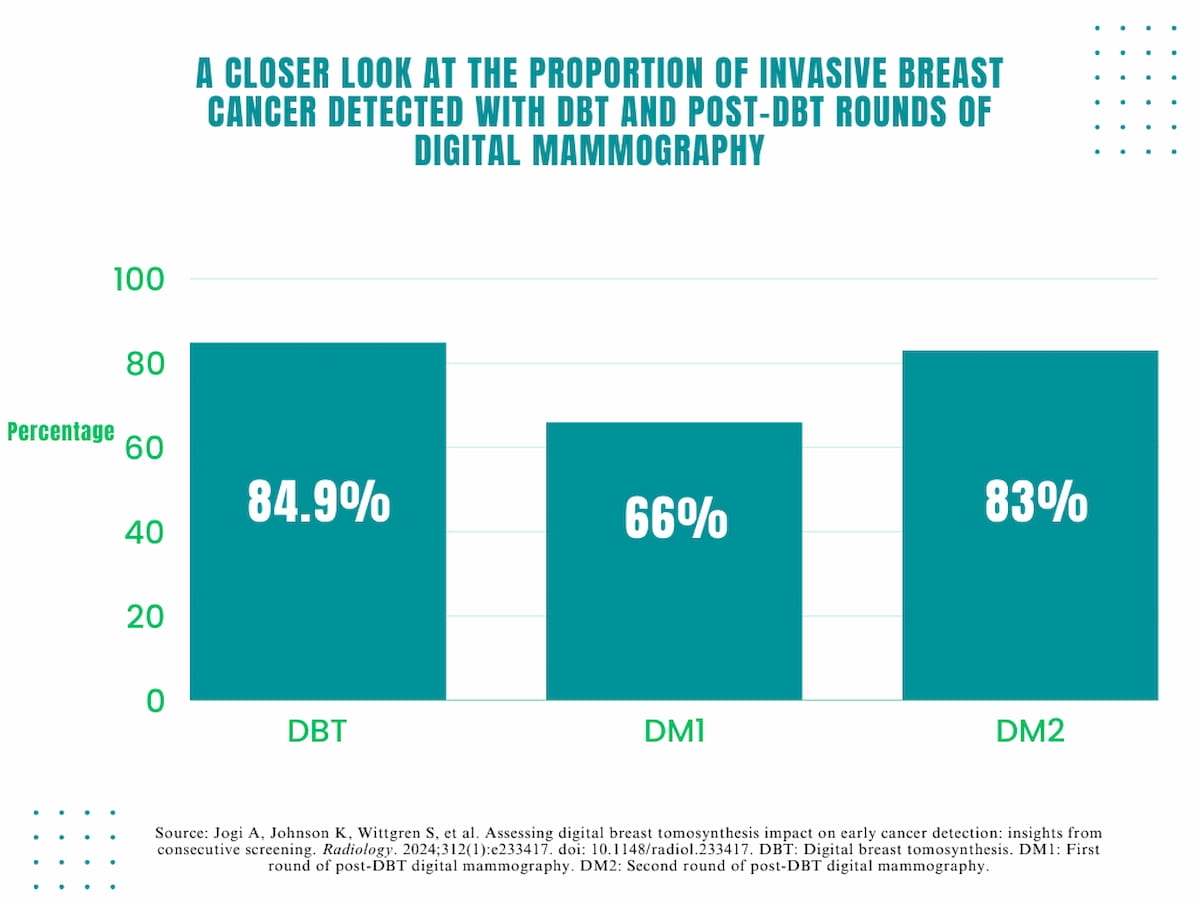Does digital breast tomosynthesis (DBT) facilitate early detection of breast cancer?
In a secondary analysis from the prospective Malmo Breast Tomosynthesis Screening Trial (MBTST), recently published in Radiology, researchers compared cancer detection rates (CDRs), invasive cancer detection and detection of luminal A-like cancers for digital breast tomosynthesis (DBT) and two consecutive rounds of digital mammography (DM) after DBT. Out of 14,848 participants in the MBTST, 12,876 women were in the DM1 group (median age of 58) and 10,833 women (median age of 59) were in the DM2 cohort, according to the study.
The researchers found that the DM1 and DM2 cohorts had significantly lower CDRs (4.6 per 1,000 and 5.3 per 1,000 respectively) than DBT (8.7 per 1,000). For luminal A-like cancers, the study authors pointed out 28 percent odds of detection in the DM1 group and 80 percent odds in the DM2 cohort.
“Both the lower CDR and proportion of luminal A-like cancers in DM1 than in DM2 indicate earlier detection of mainly slow-growing, less aggressive cancers in one prevalence round of DBT screening. Less proliferative luminal A-like cancer may be diagnosed earlier and have a better prognosis with more sensitive screening as they are subclinically present for a longer time,” wrote lead study author Annika Jogi, M.D., Ph.D., who is affiliated with the Department of Oncology and Radiotherapy at Skane University Hospital in Lund, Sweden, and colleagues.
While the proportion of invasive cancers detected with DBT was over 18 percent higher than that reported with the DM1 cohort (84.9 percent vs. 66 percent), the study authors noted an 83 percent detection rate in the DM2 group.
“The higher proportion of invasive cancers in DM2 than DM1 … is consistent with the hypothesis that DBT screening helps detect relevant invasive cancers that are less visible at DM,” noted Jogi and colleagues.
Three Key Takeaways
1. Higher cancer detection rate (CDR) with DBT. Digital breast tomosynthesis (DBT) demonstrated significantly higher cancer detection rates (8.7 per 1,000) compared to two consecutive rounds of digital mammography (DM1: 4.6 per 1,000 and DM2: 5.3 per 1,000). This indicates that DBT is more effective in identifying cancers earlier.
2. Detection of luminal A-like cancers. The study found that the proportion of luminal A-like cancers detected was significantly higher in the DM2 cohort (80 percent odds) compared to the DM1 group (28 percent odds).
3. Higher proportion of invasive breast cancer detected with DBT. The study authors noted a higher proportion of invasive breast cancer detection with DBT (84.9 percent) in comparison to the DM1 group (66 percent). Noting similar detection between DBT and the DM2 group, the researchers said this finding shows that DBT may facilitate earlier detection of invasive cancers that may be missed by mammography screening.
The researchers also found lower detection of in situ breast cancer in the DBT group (15.1 percent) and DM2 cohort (17 percent) in comparison to the DM1 cohort (34 percent).
“The higher proportion of in situ cancers in DM1 compared with the MBTST and DM2 (cohorts) suggests that DBT does not improve the detection of microcalcifications or contribute to overdiagnosis of ductal carcinoma in situ (DCIS) … ,” added Jogi and colleagues.
(Editor’s note: For related content, see “Mammography Study Finds No Additional Benefit with DBT in Women with Elevated Breast Cancer Risk,” “Mammography Study: AI Improves Breast Cancer Detection and Reduces Reading Time with DBT” and “What New Mammography Research Reveals About Radial Scars Detected with Digital Breast Tomosynthesis.”)
In regard to study limitations, the authors conceded the use of one-view wide-angle DBT and the data being entirely drawn from a single center in Sweden limit extrapolation of the study findings to broader populations. They also noted that the MBTST was not powered for subgroup analyses.
